Renovated in 2016, the De Witt Birds of Prey Center has both outdoor seating and an indoor space for programming use. Informational signs in front of each bird’s enclosure (mew) discuss interesting aspects of their natural history and why they are under the care of the center. It is free to visit, and birds can be viewed during regular trail hours 7 days a week.
Michigan is home to 11 different owl species. We have 4 of them represented here at the De Witt Birds of Prey Center. These raptors are specially adapted to thrive at night. They have large eyes to see well in the darkness, an amazing sense of hearing, and fly silently to sneak up on their prey.

Barred Owls are a large owl with a rounded head, dark brown eyes, and a yellow beak. Their face is light gray and chest is white, streaked with brown bars. Listen at night for it’s bark-like hoot: “Who cooks for you? Who cooks for you-all?”
Hunt from a perch for small mammals, reptiles, invertebrates and small birds. They also will perch over water to catch fish or wade into shallow water to catch fish or crayfish.
Typically nests in hollow trees near wetlands, adds little or no material; otherwise may use old squirrel, hawk, or crow nests
Barred Owls are a common resident in densely wooded deciduous forests throughout the Eastern United States. Recently, they have spread into the Pacific Northwest, and California.
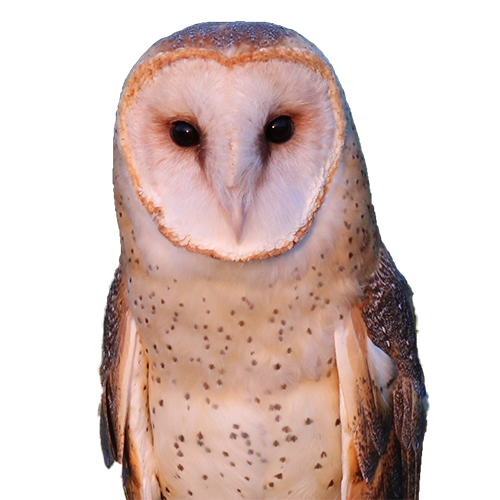
Barn Owls have a distinctly heart-shaped face and relatively small eyes compared to other owls. These lanky birds appear white when flying and their legs extend beyond their tail in flight. They are primarily nocturnal. Their vocalization is a shrill scream—they don’t “hoot” at all.
Hunts by flying low over fields and meadows, prefers small mammals such as mice, moles, shrews, rats and voles; occasionally eats birds
Nests in hollow trees, crevices, or structures like church steeples or barn lofts; makes a simple nest of shredded regurgitated pellets
Widespread throughout the world, living in open areas such as grasslands, deserts, marshes, and fields. They are endangered in Michigan.
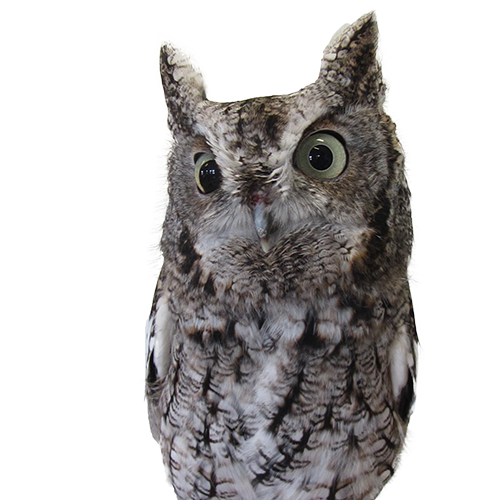
Screech Owls are the second smallest owl in North America. They come in two color morphs, meaning they can either be gray or reddish-brown in color. Complex bands and spots provide excellent camouflage, and their ear-like feather tufts help break up their silhouette. Despite their name, screech owls mostly make a trilling sound.
Hunts from low perches where they pounce on small rodents and small birds; they also commonly eat insects during the warmer months.
Typically nest in tree cavities or nest boxes; can fit in tree cavities as small as a tennis ball.
Found throughout the Eastern half of the United States and Mexico. These small owls can live in a variety of habitats, including cities.
The De Witt Birds of Prey Center has 3 of the 7 hawk species found in Michigan. With their excellent eyesight, strong wings and powerful talons, these birds are adapted to survive and thrive in many different habitats.
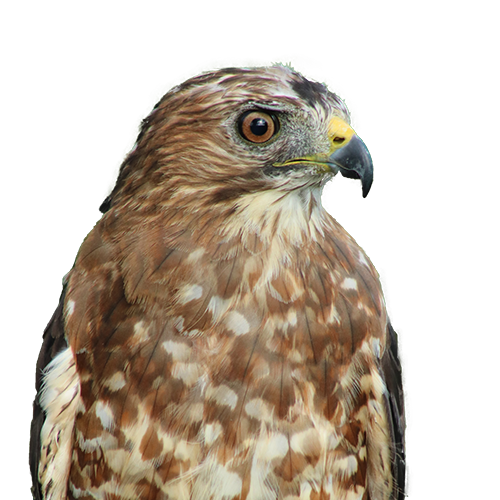
Broad-winged Hawks are small, similar in size to a crow. Their dark brown back is contrasted by a pale underside which is barred with reddish brown. In flight, their wings appear pale with a black outline. The tail has black and white bands of nearly equal widths.
Hunt from a perch in forests. Their most common prey are small mammals such as chipmunks, shrews, and voles. Also known to eat amphibians, reptiles and invertebrates.
Typically built in a deciduous tree using dead sticks and lined with lichens, bark, and green leaves. Pairs will sometimes reuse nests from previous years or even fix up old nests from other species of birds.
Common throughout eastern North America in deciduous forests. Migrate to Central and South America in winter to find available prey, often traveling in a group with thousands of other Broad-winged Hawks called “kettles”. Commonly found deciduous or mixed forests and will nest near openings or bodies of water.
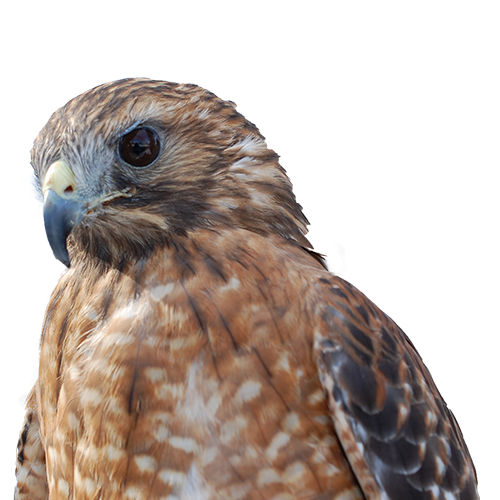
Red-shouldered hawks are large, broad winged hawks with long, banded tails and a heavy body. Their brown back is contrasted by an overall reddish underside which is barred from throat to belly. Reddish upper wings give them the appearance of red shoulders and the origin of their name.
Hunts while perched on a treetop or by soaring over woodlands. When they see their prey, typically a small rodent, rabbit or reptile, they descend swiftly and snatch the prey using their feet.
Builds a stick nest near the trunk of a tree, lined with shredded bark, leaves, and moss.
Red-shouldered Hawks prefer deciduous forests with an open sub-canopy, but can sometimes be found in forested suburbs. Once one of the most common hawks in Eastern North America, it is currently listed as a threatened species in Michigan due to the loss of forest habitat.
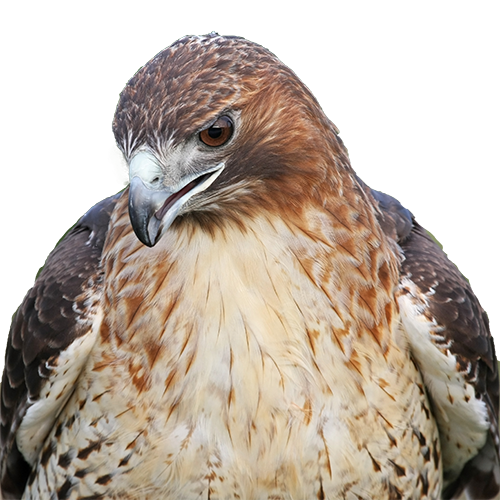
Red-tailed Hawks are large, stocky, broad winged hawks. They have a dark brown back with white chest and legs. Most birds have a “belt” of brown streaked feathers across the lower belly. The rusty red tail appears in adults in their second year.
Ambush predator; hunts from a perch or by soaring over open fields. Commonly seen along roadsides looking for their prey. When they see a small mammal (such as mice, squirrels, rabbits or groundhogs) they swoop down quickly and catch their prey using their strong feet. Occasionally will eat birds such as pheasants, as well as snakes and carrion.
Stick nests up to three feet across are constructed in large trees or on ledges and may be reused year after year.
Common throughout North America in a variety of open habitats including forest edges, plains, desert, scrublands, grasslands, roadsides, fields and pastures, parks, broken woodland, and (in Mexico) tropical rainforest. It is the most common hawk in Michigan.
Falcons are some of the fastest animals on planet earth. Their stiff flight feathers and long pointed wings and tail help them to maneuver quickly and accurately through the air to capture their flighted prey. The De Witt Birds of Prey Center is home to 2 of the 4 species of falcon found in Michigan.
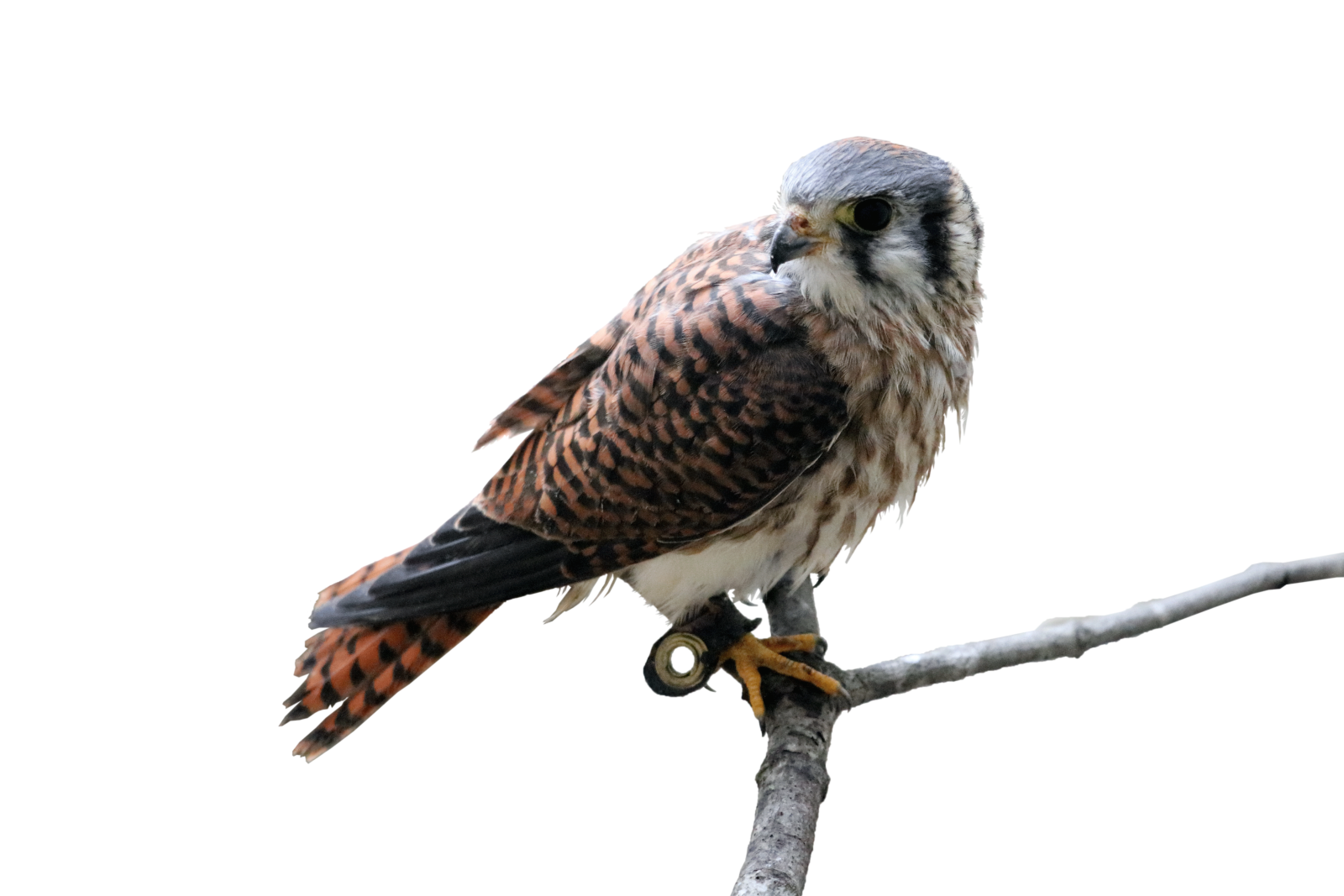
Kestrels are small falcons that prefer open habitats including deserts, grasslands, rural fields, and open city parks. They can often be found perched on wires, fence posts and solitary trees. Their distinct facial feathers (malar stripes) can be seen with the naked eye as can the chestnut-brown color of both males and females. Adult males can be differentiated from females by the grey on their wings and the chestnut-colored cap on their head.
Their distinct style of hovering and hunting over a habitat in search of small prey is characteristic.
Formerly called a “Sparrow hawk”, they will readily take small birds as prey. However, during warmer seasons, they are more likely to survive by eating insects and other invertebrates. Other prey items may include small mammals, snakes, lizards and frogs.
Kestrels are cavity nesters that prefer old woodpecker holes, hollow holes in trees, ledges of buildings yet readily take to nestboxes. Their nests are simple with no additional nesting material added.
Widespread throughout North and South America. Year-round populations exist throughout much of the continents with the most northern latitudes primarily used for breeding territory. Some kestrels migrate however many stay in the same range year-round.
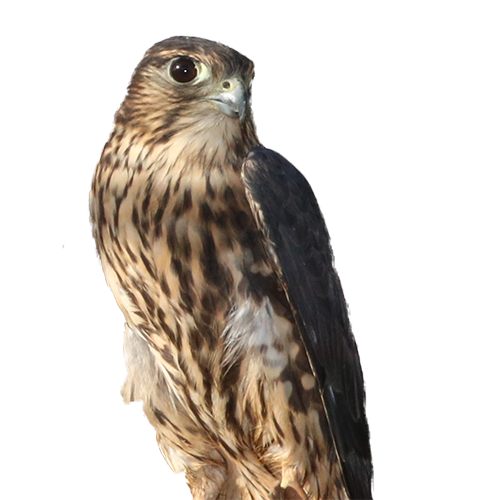
Merlins are small falcons that are found in grasslands and open woods. They have long, pointed wings and long, banded tails. Merlins are less distinctively marked than other falcons. They have dark brown or slate-colored backs and heavily streaked buff-colored chests. Females tend to be darker colored than males.
Hunts from the air where it mainly pursues other birds; occasionally catches insects or rodents.
Typically nests in trees; uses old nests of crows, hawks, or squirrels.
Currently listed as Threatened in Michigan; can be found in forested openings, grasslands, forest edges, and along rivers and coasts in the entire US during migration.
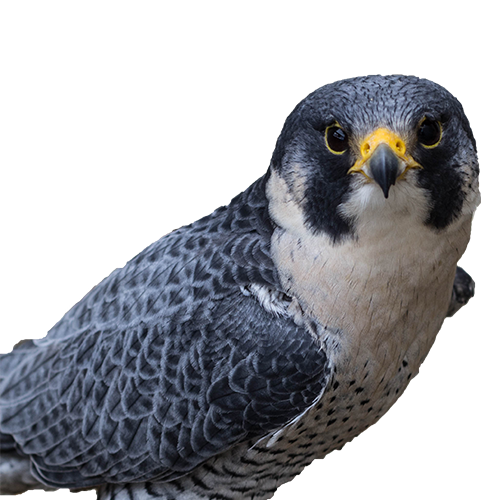
Peregrines are stocky falcons that are designed to fly at extreme speeds while chasing prey. They have long pointed wings, long slender talons, and dark eyes. Peregrines are typically slate gray on the back and buff colored on the belly with black barring.
Primarily eats birds, especially waterfowl and pigeons; hunts from very high perches or while soaring; dives to strike prey in the air usually killing on impact.
Simple depression in dirt or debris on a
high ledge; suitable sites include cliffs and skyscrapers.
The Peregrine Falcon is found on all continents except Antarctica, and on many oceanic islands. They migrate throughout North America and can be found along rivers and coastlines or in cities; anywhere there are cliffs to nest on. Though currently listed as Endangered in Michigan, Peregrine Falcon populations have expanded since the ban of DDT, and the species has recovered enough to be removed from the Endangered Species list since 1999.
There are two species of eagles commonly found in North America, both of which can be found at the De Witt Birds of Prey Center. Due to their large size, great strength, and ability to spot prey from miles away, eagles are excellent hunters and considered apex predators.
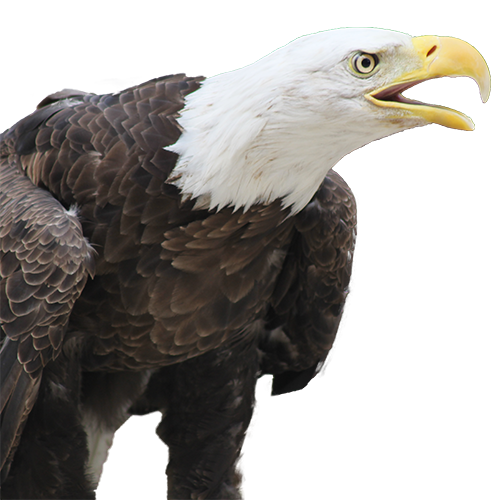
Bald Eagles are large, stocky birds with a dark-brown body and a white head and tail. They have large yellow beaks and feet. In flight, their large wings appear straight-edged and are held flat. Groups of eagles congregate where prey is abundant, such as suitable areas along the Great Lakes.
Bald eagles typically hunt from a perch, but also while in flight. Most common prey is fish but will also eat birds, reptiles and mammals (such as muskrats, rabbits and more). They are also known to steal food from other birds of prey and are active scavengers.
Constructs a nest of sticks up to fifteen feet across, usually in a tree near water, reused each year.
Found throughout the United States and Canada, common near coasts, rivers, lakes, and reservoirs.
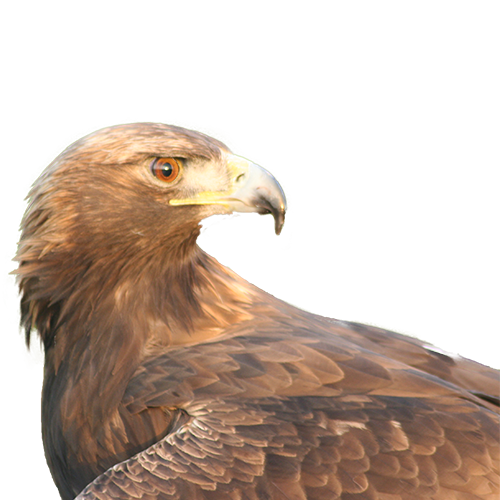
Golden Eagles are large, long-winged, brown birds. Unlike the Bald Eagle, Golden Eagles have feather-covered legs. Adults have brown eyes, gray beaks, and a golden tint on the back of their neck. Juveniles have white patches at the base of the tail. Golden Eagles prefer open country and avoid stretches of forest or developed areas.
Hunts from the air, often in spectacular dives; mainly eats jackrabbits; will take other small mammals, birds, and reptiles; also capable of taking down sheep, deer, or other large mammals.
Constructs a large stick nest 8-10 feet across lined with leaves or brush; often located on cliffs, occasionally in trees.
Found throughout the Northern Hemisphere in partially or completely open country, especially around mountains, hills, and cliffs in any habitat type ranging from arctic to desert. They are rare in the Eastern United States.
There are 2 species of vultures found in North America. The De Witt Birds of Prey Center houses 1 of these species. Although they may be smelly and looked down on for eating carrion (dead animals), vultures play an important role in the ecosystem.
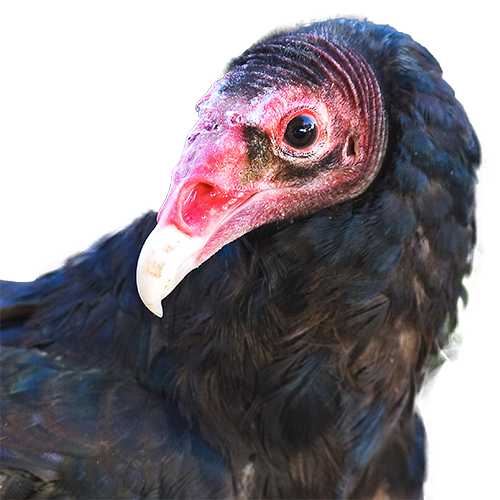
Turkey Vultures, also known as “Buzzards,” are large birds with long broad wings. They have red, unfeathered heads that are usually not visible during flight. When soaring, wings are held in a shallow V shape, wing tips curve upward and appear silvery. Vultures grunt or hiss to communicate. Although related to other birds of prey, vultures lack the ability to grasp with their feet and are not considered raptors.
Scavengers; eat carrion (dead animals) located by sight or smell while soaring, often seen feeding on roadkill.
Eggs laid on bare ground, sometimes
in caves or decaying tree stumps, no nest material used.
Found throughout the UnitedStates and Mexico; migrates to southern states and Central America during winter months.
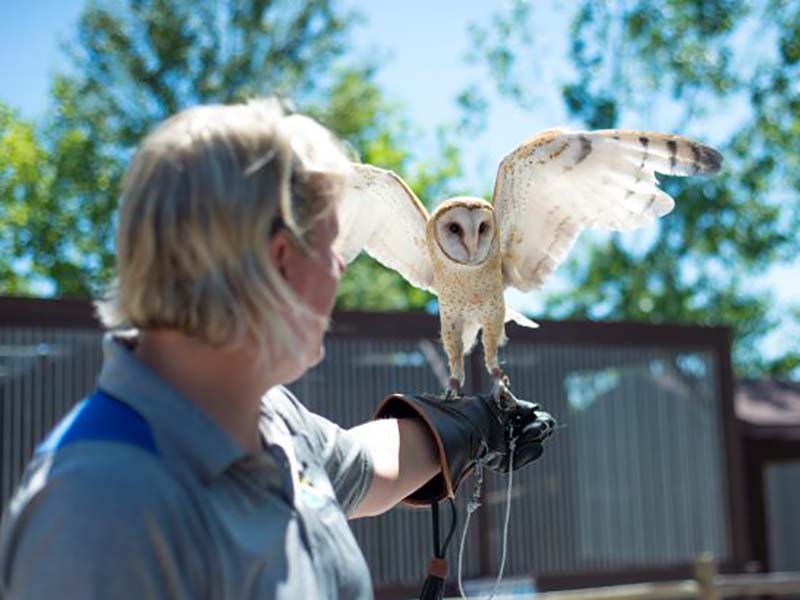
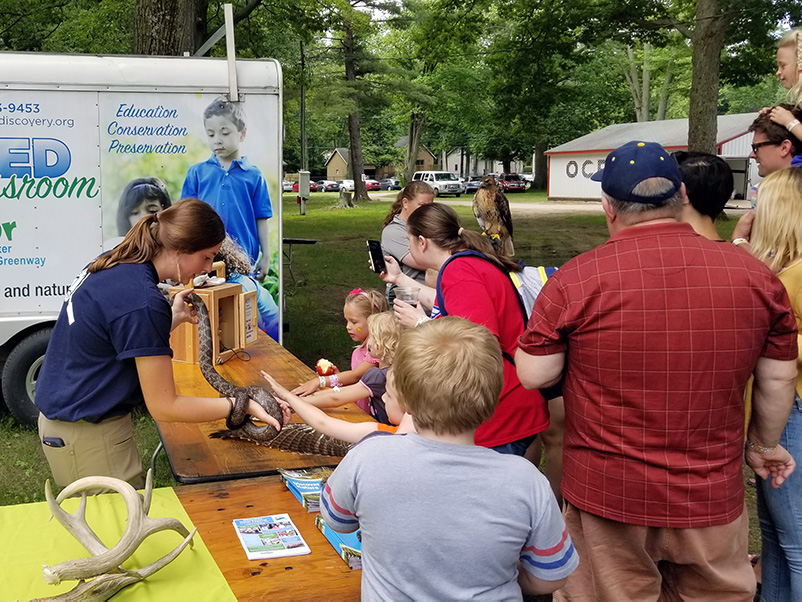
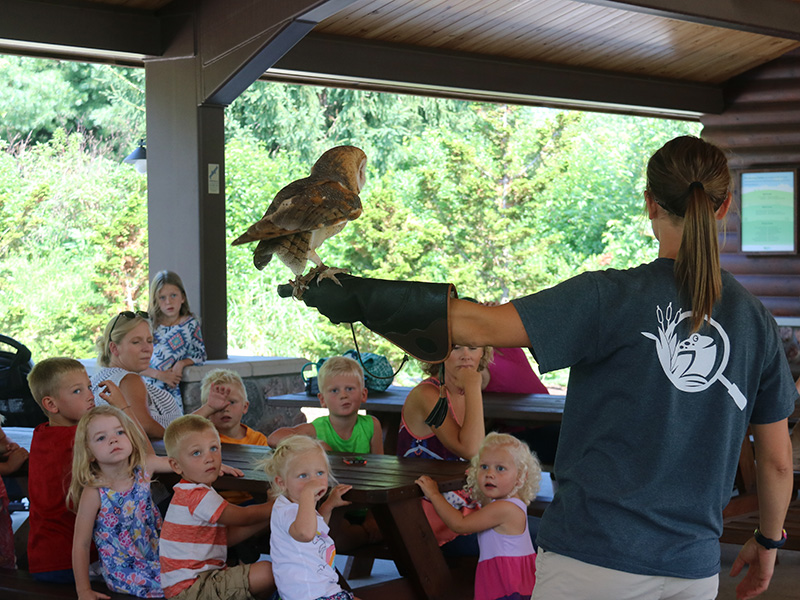
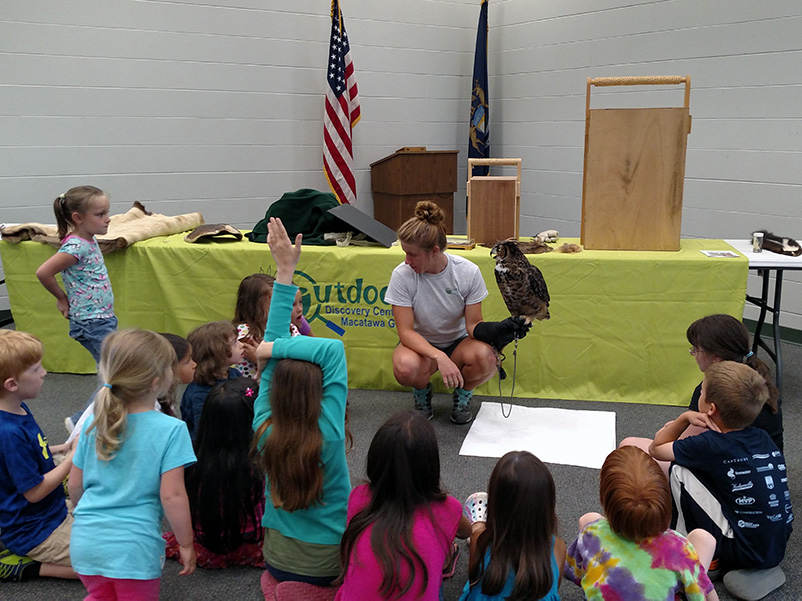
Our feathered ambassadors allow us to offer a variety of educational programs to the public. From community events to school visits, wildlife booths and more, we’re sure to have an experience that’s right for you! Check out our Programs page or get in touch with us to learn more.
A bird of prey, also known as a raptor, is a carnivore that hunts other animals. It differs from other birds that eat animals because raptors catch prey with their feet. Their keen eyesight helps them find their prey while their sharp beak and talons allow them to catch and kill their prey.
All of the birds housed in our facility have been permanently injured or disabled meaning they can not return to the wild. We maintain permits with the Michigan Department of Natural Resources and the United States Fish and Wildlife Service to house the birds and use them for educational purposes.
The ODC does not have a wildlife rehabilitation license, and cannot take in injured wildlife. All of our birds come from state licensed rehabilitators who determined the birds would not survive on their own. If you find an injured bird or another wild animal, you can look up a licensed rehabilitator at michigandnr.com/dlr.
We feed our birds over 15,000 items each year including mice, rats, quail, and fish. Birds of prey don’t drink water! They get all the water they need from their food. The water bowls you see out in warm seasons are for bathing.
Visitor Center Hours:
Phone: (616) 393 – 9453
9:00 AM – 4:00 PM Monday-Friday
10:00 AM – 3:00 PM Saturday
All Trail Hours:
Sunrise to Sunset
No Entry Fee – Donations Welcome
4214 56th Street Holland, MI 49423
ODC Network 2021. All Rights Reserved